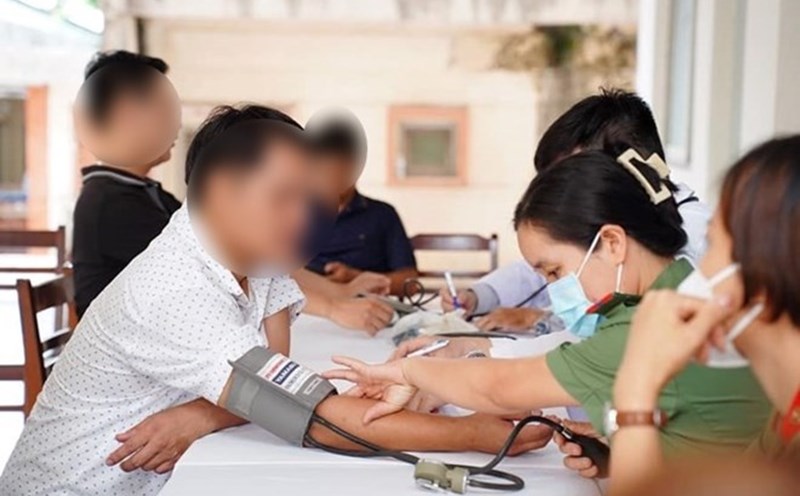Reducing the distinction between health insurance examination and service examination
Ms. Nguyen Xuan An (Chuong My District - Hanoi) went to the Central Endocrinology Hospital for examination. When she arrived at the hospital, she saw a specialist examination service so she chose to immediately see the service even though she had health insurance. "Service examination often has quick, high-quality procedures, while using health insurance requires a long wait and I am worried that service quality is not guaranteed" - Ms. An shared.
At major hospitals such as Viet Duc, Bach Mai, Cho Ray, people have to queue from 4-5 am to get health insurance examination numbers, at a cost of only about 50,000 VND/time. Meanwhile, service examinations, especially for experts, associate professors, and doctors, although expensive (can be up to 500,000 VND/examination), save time and improve the quality of examinations.
Many large specialized hospitals such as oncology, cardiovascular disease, Orthopedic trauma, obstetrics and Pediatrics in urban areas are overloaded, causing health insurance patients to wait a long time.
To overcome overload and service differences, the new health insurance policy focuses on improving the quality of medical examination and treatment at public hospitals and ensuring fairness in payment.
Accordingly, the Ministry of Health has implemented many specific measures, including expanding payment of 100% of medical examination and treatment costs at public health facilities at the initial level, helping to reduce the financial burden on people.
Ms. Vu Nu Anh - Deputy Director of the Department of Health Insurance (Ministry of Health) - said that an important improvement from 2025 is the payment of 100% of medical examination and treatment costs at primary health examination and treatment facilities and basic health insurance facilities.
Circular No. 37/2024/TT-BYT, health insurance participants will be covered by the Health Insurance Fund for all medical examination and treatment costs, helping people access quality healthcare services without having to worry about costs. This is especially important in reducing the burden on upper-level hospitals and ensuring that people can receive timely health care right at the grassroots level.
A notable new point in the health insurance policy is to allow private health facilities to participate in health insurance payments from 2025. However, the payment level will be applied according to the health insurance price framework approved by the Provincial People's Council for public facilities in the area.
General health insurance examination and treatment without administrative geographical discrimination
Sharing about the issue of expanding health insurance benefits for people, Deputy Minister of Health Tran Van Thuan said: The amended Law on Health Insurance (HI) effective from July 1, 2025 stipulates the health insurance benefits when implementing the health insurance examination and treatment (HI) level in the direction of not distinguishing administrative boundaries by province.
According to this regulation, patients are paid 100% of the benefits when receiving initial medical examination and treatment nationwide, 100% of the benefits when receiving inpatient medical examination and treatment at the basic level nationwide, 100% of the benefits when receiving medical examination and treatment at any basic and specialized medical facility that before January 1, 2025 is determined to be a district level. In particular, in some cases of rare diseases, serious diseases... patients are allowed to go directly to specialized health care facilities.
A notable point in the new health insurance policy is the updated list of drugs with payment. Previously, this list was limited, especially for drugs specifically for chronic diseases, underlying diseases or serious diseases. Circular 37/2024/TT-BYT has overcome this by clearly defining the principles and criteria for developing a list of health insurance drugs.
From 2025, the list of health insurance drugs will be expanded, adding many new types of drugs, including drugs to treat rare diseases and chronic diseases. The drugs will be classified and adjusted in the direction of prioritizing modern treatment regimens, suitable for clinical practice and domestic needs.
The Circular also clearly stipulates the drug bidding process to limit drug shortages, control prices and help people access quality drugs at low costs. This is a positive signal, especially for patients with incurable diseases.
In addition to updating the drug list, the Ministry of Health also expands the scope of health insurance payment for modern medical services. Previously, many techniques such as ultrasound chupage, tumor monitoring tests, emergency blood filtration, etc. were not fully covered by health insurance, forcing people to pay part of the cost themselves.
To overcome this, Circular 39/2024/TT-BYT has expanded payment for a number of technical services, especially in cancer diagnosis and treatment. The new regulation not only reduces the financial burden on patients but also promotes the application of advanced medical technology in treatment.











